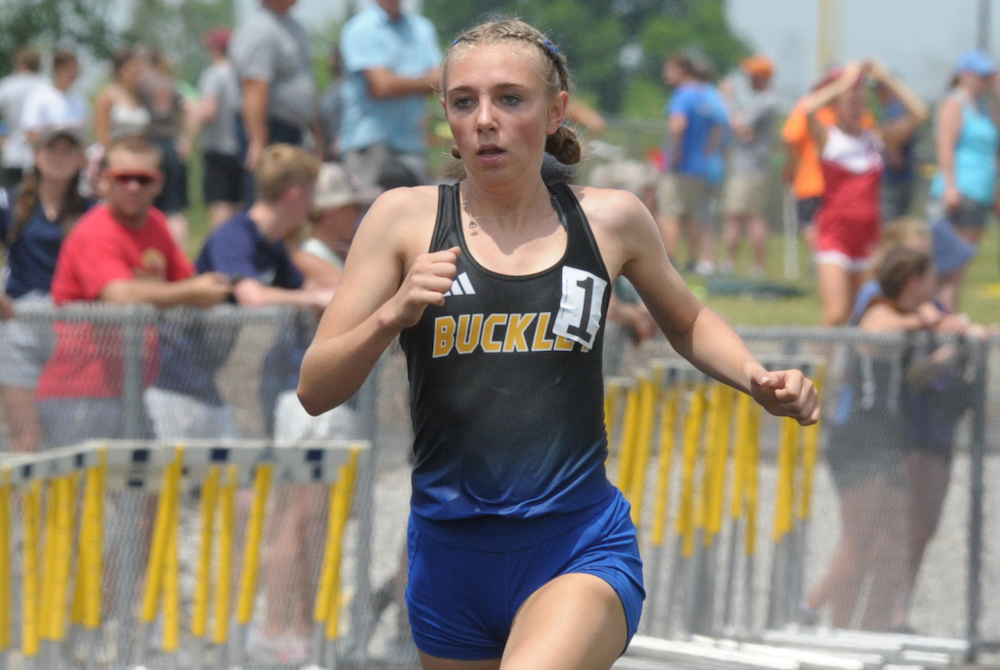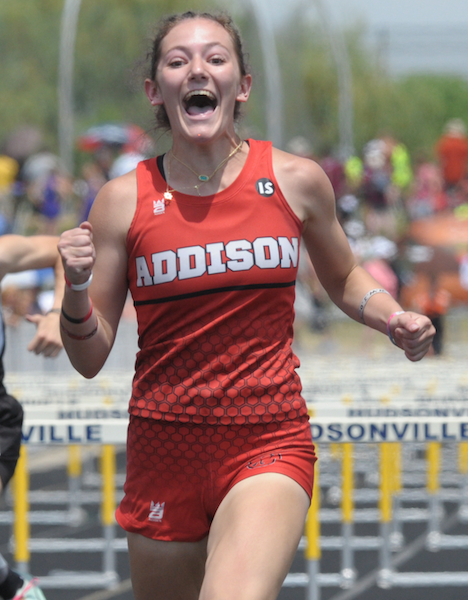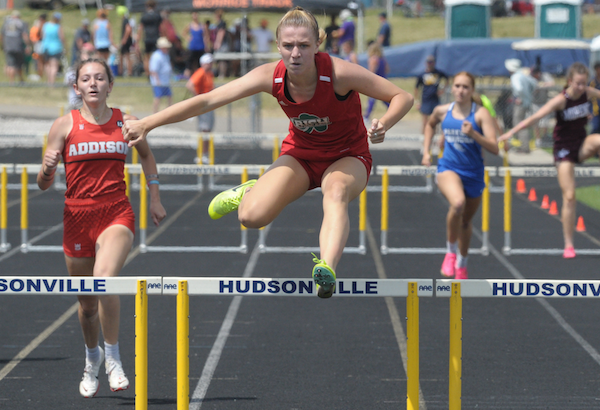
Speedy Sprint-Distance Tandem Carries Buckley to 1st Championship
By
Tom Lang
Special for MHSAA.com
June 3, 2023
HUDSONVILLE – Buckley capitalized on the balance of junior distance star Aiden Harrand and freshman standout sprinter Brooklyn Fraeze to rack up the points needed to win the Lower Peninsula Division 4 track & field championship with 52 points Saturday at Hudsonville.
The team title was Buckley’s first in girls track & field.
Harrand won the 1,600 for the third-consecutive year and added titles in the 800 and the 3,200, leading her team to the championship. Those three wins followed her cross country Finals championship from the fall.
“I think it’s kind of fun,” she said about racking up the titles. “My team motivates me, I mean we’re in it as a group and my points matter, so I do it for them.
 “It was a cool experience to have, winning those two,” she said about the two longest races, the 1,600 and 3,200, which were the hardest of the overall meet due to the low 90s/high 80s heat and searing sun all day. Race officials allowed the unique opportunity for coaches to spray the runners with water and give them water bottles.
“It was a cool experience to have, winning those two,” she said about the two longest races, the 1,600 and 3,200, which were the hardest of the overall meet due to the low 90s/high 80s heat and searing sun all day. Race officials allowed the unique opportunity for coaches to spray the runners with water and give them water bottles.
“The water on the backstretch was so nice, and I’m really glad it was there,” Harrand said about the unusual experience. “My coaches were spraying me, and that was so nice to have.
“And our girls took first overall, so we’re really excited for that. Me and Brooklynn (Fraeze) had lots of points, and our 4 x 400 (eighth place) got us the last points we needed. It was amazing, and this is why we do it.”
Fraeze, a freshman, won 100 dash with a personal best of 12.47. She added a runner-up finish in the 200.
“I was like, oh my gosh I’m doing it, the finish line is right there,” she said about the last 10 meters of the 100, as she finished just ahead of Molly Brown of Addison (12.57).
Brown later won the 100 hurdles.
“The girl who got second place, I felt her at like the halfway point and I was telling myself ‘I’ve got to go,’” Brown said of the hurdles win. “And after I finished the race, I was thinking about it and I heard my family yelling for me. I saw my dad and I started crying; there’s just a lot of emotions.”
Her team finished sixth.
Portland St. Patrick was the team runner-up, just three points back at 49. Indian River Inland Lakes took third, Fowler was fourth and Hillsdale Academy took fifth.
Mount Pleasant Sacred Heart senior Anna Plum successfully defended her 300 hurdles title.
 “I think I was actually seeded third, but I had high expectations since I won last year and I really wanted that again,” Plum said. “It’s kind of like validation.
“I think I was actually seeded third, but I had high expectations since I won last year and I really wanted that again,” Plum said. “It’s kind of like validation.
“We put in great practices, and God, honestly,” she credited as factors for her win and the team’s focus. “We are Sacred Heart and believe in God and put a lot of trust in that.
“My feet are pretty hot right now,” Plum added about the weather conditions. “I bet I’ve got some pretty big blisters. I don’t even know how the 3,200 runners do it. It was insane today.”
Rylee Scheurer led St. Patrick by winning the 200 (25.82), and Natalie Wandrie keyed Inland Lakes’ pursuit with wins in the shot put (39-8) and discus (128-11). Frankfort in the 400 (50.68), Fowler in the 800 (1:47.17) and Hillsdale Academy in the 1,600 (4:08.08) and 3,200 (9:57.73) were relay champions, and Beal City’s Kaylee Locke won the 400 (58.55).
Marlette’s Olivia Findlay won the high jump (5-4) and Wyoming Potter’s House Christian’s Sohanny Gonzalez-Castillo won the long jump (17-4). Deckerville’s Rebecca Moeller was first in the pole vault (10-6).
PHOTOS (Top) Buckley's Aiden Harrand sets the pace in the 1,600 on Saturday. (Middle) Addison's Molly Brown celebrates her win in the 100 hurdles. (Below) Mount Pleasant Sacred Heart's Anna Plum clears a hurdle during the 300. (Photos by Ken Swart/RunMichigan.com.)

Hastings Relays Reigns as State's Oldest Continuous Track & Field Meet
By
Steve Vedder
Special for MHSAA.com
April 10, 2024
Bob Branch remembers dabbling in other sports, but his first love was always running.
 The Hastings High School graduate admits he could never hit a baseball, football didn't especially appeal to him and basketball was just another way to spend time with friends. But for Branch, now 93, there was always track. That's the sport where his fondest and sharpest memories remain. And if you're talking track, many of his favorite memories come from participation in the state's oldest continuous track meet, the Hastings Relays.
The Hastings High School graduate admits he could never hit a baseball, football didn't especially appeal to him and basketball was just another way to spend time with friends. But for Branch, now 93, there was always track. That's the sport where his fondest and sharpest memories remain. And if you're talking track, many of his favorite memories come from participation in the state's oldest continuous track meet, the Hastings Relays.
Always held in early April, the meet dates back to 1937 – a bygone time that saw the first hostilities of World War II, gas at 20 cents a gallon and a loaf of bread selling for a dime.
And at a dusty old track surrounding the county fairgrounds in Hastings, a small relay event that included a scattering of participants from a dozen high schools was taking its first tentative steps.
Branch recalls a time when kids would run home after track practice because there were no buses, inexperienced young coaches had little actual knowledge of running fundamentals, and athletes looked at the sport as an afterthought after spending most of their high school days playing football and basketball.
 For Branch, the relays were the ideal way to ease into the track season.
For Branch, the relays were the ideal way to ease into the track season.
"I just liked to run," said Branch. "I remember I anchored a relay with my brother, and it always seemed cold when we had that meet. I remember teams would come from all over and you saw a lot of good athletes. Everybody seemed to have someone who was really good. Track wasn't very popular at that time, but I have a lot of good memories from running."
The Hastings Relays, which has changed formats and even names during its nearly nine-decade history, would traditionally kick off the track season. The meet was originally held at a makeshift quarter-mile track which surrounded the town's fairgrounds and was part of the city's annual Hastings Carnival – the track would become the midway during fair time.
The meet eventually moved to Johnson Field when the football field was dedicated in 1949 and ballooned to as many as 50 teams at its peak in 1957. For more than seven decades it was known as the Hastings Relays and then the Hastings Co-Ed relays before becoming the current Hastings Invitational, with the latest edition scheduled for Friday.
Johnson Field had a cinder track before it became an all-weather surface in the 1980s. During a time long before computers would be used to organize meet heats in mere minutes, Hastings coaches of all sports – defined as "volunteers" by the athletic department – would meet on the Friday before competition to hash out events.
People associated with the meet still recall the camaraderie built on those long Friday nights, followed by working what would often become 10-hour meets. Steve Hoke has been involved since watching his father, Jack, who coached teams at 15 of the meets beginning in 1951 and also had run in the first Hastings Relays. Steve Hoke later competed in the Relays as well during the early 1970s before becoming an assistant track coach, later the Hastings athletic director and now a volunteer worker.
"It was always a huge deal," said Hoke, who said the meet began as a pure relay event before transitioning to its current team format in the 1990s. "I remember we'd line the track the night before, and all the coaches would come to the house to organize everything. There was a brotherhood.”
 If you quiz many of the fleet of volunteers who've worked the relays over the years, each has a different memory from the meet. While Hoke describes the brotherhood and Branch the outstanding competition, others remember weather and the time a thunderstorm wiped out the line markings on the cinder track, or waking up to find three inches of snow that caused a rare cancellation of the meet. Others recall the shock of moving from the cinder to all-weather track or using the meet as an early measuring stick of what it would take to qualify for the state meet. The real old-timers remember the meet disappearing for three years during World War II.
If you quiz many of the fleet of volunteers who've worked the relays over the years, each has a different memory from the meet. While Hoke describes the brotherhood and Branch the outstanding competition, others remember weather and the time a thunderstorm wiped out the line markings on the cinder track, or waking up to find three inches of snow that caused a rare cancellation of the meet. Others recall the shock of moving from the cinder to all-weather track or using the meet as an early measuring stick of what it would take to qualify for the state meet. The real old-timers remember the meet disappearing for three years during World War II.
Hastings native and Western Michigan grad Tom Duits was the state’s second collegian to break the four-minute mile when he ran a 3:59.2 at a meet in Philadelphia in 1978. Duits, who ran in three Hastings Relays, was in line to join the U.S. Olympic team in 1980 before the United States pulled out of the games due to tension with Russia.
Duits has his own memories of the meet and the competition he faced there.
"I remember sunshine and being excited to be competing again. There were all these athletes swarming around; it was an awesome display of talent," he said. "It was always one of the best meets we'd be in. You could pretty much see the level of runners who would be at state, which made it a big deal. It was always early, but you could tell where you stood. It was great exposure."
Hastings track star Wayne Oom competed in four Hastings Relays from 1984-87. One of his sharpest memories was the difference between running on a raw cinder track versus the far more comfortable all-weather surface.
"Those cinders would grind into your skin," said Oom, part of the Hastings school record in the two-mile relay. "But I think it helped us because when we'd go to other tracks, it seemed we would run faster. I remember how competitive it was, especially in the distances. There were some great runners."
While participants have their unique memories, so do coaches. Former Saxons coach Paul Fulmer remembers 2008 when his team finished first on the boys side of the meet while his wife, Grand Haven coach Katie Kowalczyk-Fulmer, saw her girls team win the championship.
 "I knew we were one of the favorites to win because we were usually near the top of our conference and Regional," he said. "But then Katie's team was pretty good, and it was cool for them to win too."
"I knew we were one of the favorites to win because we were usually near the top of our conference and Regional," he said. "But then Katie's team was pretty good, and it was cool for them to win too."
Fulmer, who coached Hastings from 1978-81 and then 1985-2010, said at least part of the meet's popularity was derived from a unique way of scoring. Instead of individuals earning points solo, participants worked in pairs. For instance, two athletes would combine their shot put or long jump scores. New events such as the 1,500 relay and sprint medley were added.
"We had a tradition of being the state's oldest meet, and that was a big deal," Fulmer said. "And we ran a good relay; that attracted teams too. We took a lot of pride in that.
"And we'd get quite a lot of people to come to the meet. We'd set up until like 9 or 10 p.m., and then we'd have a party with all the coaches on Friday night."
While the meet has stretched 87 years, Branch said early participants and current runners have one thing in common: a drive to win. Branch ran in an era when the popularity of high school track was in its infancy. Today some of the best all-around athletes at a school are involved in the track program. The relays span the nearly nine decades in between.
"The quality of teams has gotten better and better," said Branch, the 1947 Lower Peninsula Class B Finals champ in the 220. "And this has made for a better meet. We would get guys who played football or baseball kind of drift into track, and that made the sport better. I think people began to appreciate track because we'd get teams from all over.
"We went from not really knowing what we were doing to track being a good sport. Even then, I'm not sure we appreciated what we had. We really liked the Hastings Relays and always wanted to do well there. It became popular and quite an honor to do well. Those are the kind of things I remember."
PHOTOS (Top) Racers run at the Hastings Relays, with several more awaiting their turns to compete at the longtime meet. (2) The author wrote on the 50th anniversary of the Relays for the Hastings Banner nearly 40 years ago. (3) Past athlete, coach and athletic director Steve Hoke shows some of the Relays awards from the 1930s. (4) Tom Duits was one of the state’s biggest track stars of the 1970s and ran in three Hastings Relays. (Top photo by Dan Goggins, Hoke photo provided by Steve Hoke and Duits photos provided by Tom Duits.)

